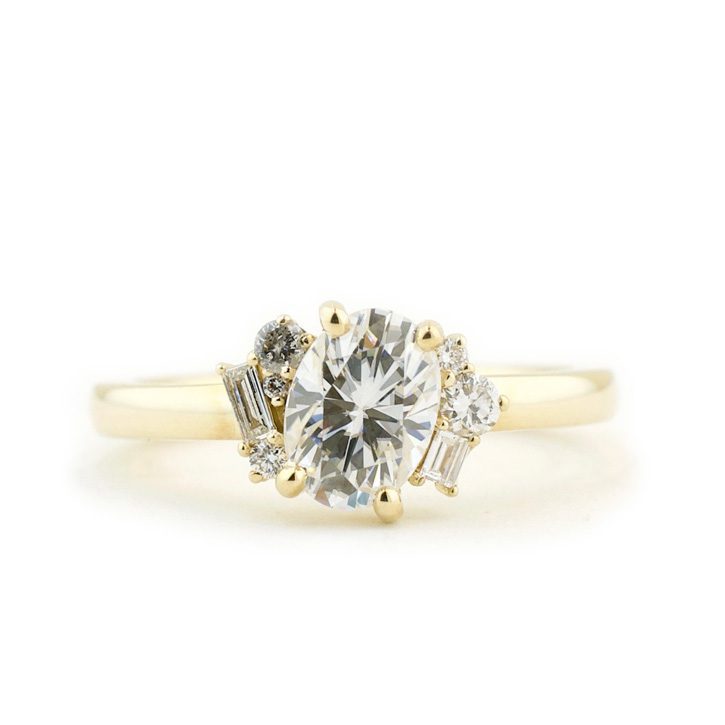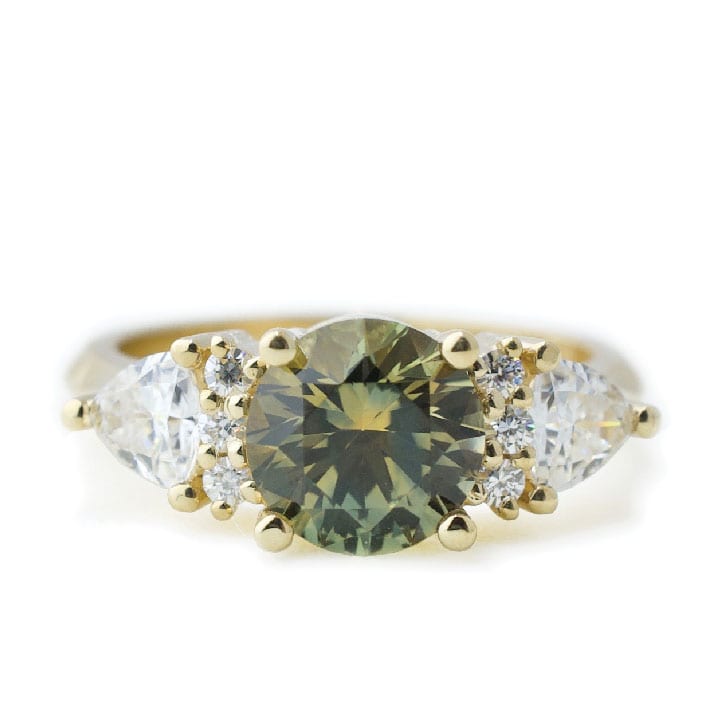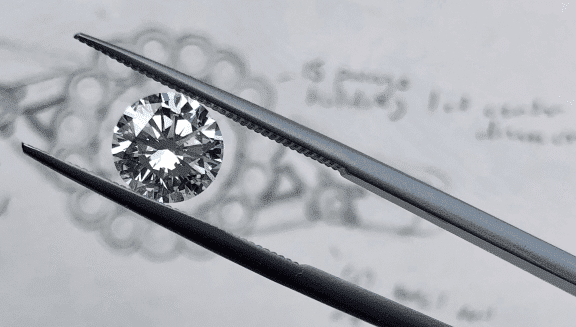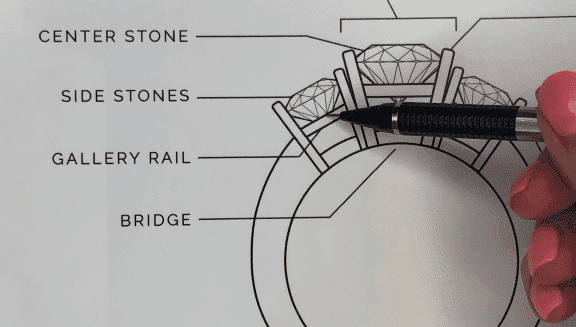Sustainable and Ethical Engagement Rings: What Are They?
For many couples, finding an engagement ring that represents their relationship and their values is a top priority. While the jewelry industry often faces scrutiny for questionable ethics and unsustainable practices, it is possible to create an engagement ring that is 100% true to your values. We’re breaking down all of your options so that by the end of this article you are going to know the hard questions to ask when wedding ring shopping in order to ensure that your ring is both eco-friendly and ethical.
What is a sustainable and ethical engagement ring?
There are two components you need to consider when shopping for a sustainable and ethical engagement ring: the metal and the stones. You need to ensure that both the metal and the stones in your ring were procured in a way that is both planet and people-friendly. The origin of these materials is the most important factor here – if you can not name the origin of your engagement ring metal and stones, then you cannot say for sure that your ring is eco-friendly or ethical. We will use the terms sustainable and ethical interchangeably throughout this post.
Sustainable Wedding Ring Metals
The Sarah ethical engagement ring is set in recycled rose gold.
1. Regular Mined Metals
You will find regularly mined metals at most jewelry stores that manufacture their jewelry. There really isn’t necessarily any transparency about where those metals came from, because they are sourced globally. Because there isn’t a lot of transparency, it’s really difficult to find out what exact mine the metal in that piece of jewelry came from and what the mining standards were both from an environmental standpoint and a workers rights standpoint. When you choose the regular mined metal route, there is a risk that where that metal was sourced does not meet your standards as far as the environmental impact and treatment of workers, so it is not a recommended option when you are really trying to hone in on that sustainable engagement ring. Bottom line, you really just don’t know what you’re getting.
2. Fairmined Metal
The second metal option available is fairmined metal. This type of metal is admittedly hard to find, but when you go this route for your wedding ring, you get the peace of mind knowing that where that metal was sourced from was easy on the earth and the standards for the workers are really high. Typically, mines producing fairmined metals are smaller-scale mines that support entire communities and are focused on responsible practices that protect and minimize the environmental impact of that mine. It will be much easier to find the fairmined metal option from a smaller, custom or artisanal jeweler than a big box jewelry store, because you can ask them what metals they use and there’s a lot more transparency in the process.
3. Recycled Metal
If you are really looking to reduce your environmental impact, going the recycled metal route is a great option. These are basically metals that have already been mined and used in some way, that have gone back through a refinery and are ready to be remade into a piece of jewelry. Recycled metals are the same exact quality as newly mined metals and no strength is lost in the refining process. The recycled metal option is our personal favorite here at ASJ and we use only recycled metals in our custom engagement rings. This is a really great option for your eco-friendly engagement ring because you are using what we already have, what’s already been mined, and you aren’t contributing to the continuation of bad environmental practices. Again, you are more likely to find recycled metals with custom or smaller jewelers, but it is much easier to find jewelers who use recycled metals than jewelers who use fairmined.
Sustainable Engagement Ring Stones
This Montana Sapphire Engagement Ring features a center stone that was sourced in the U.S.
The sourcing of precious gemstones and diamonds historically has caused a lot of conflict, violence, and disregard for the environment. Currently, the UN has a system called the Kimberley Process that is meant to prevent the flow of conflict stones to consumers, but frankly this process simply is not thorough enough to prevent stones like these from entering consumer markets. When looking for sustainable and conflict-free stones for you engagement ring, the first question to really ask is “Where did this stone come from?” because the origin of that stone will tell you everything you need to know about it’s story.
1. Mined Stones
If you are in love with the idea of having a stone that comes from the earth, something raw and natural, then where we are at today in the industry is that you’re going to want to get that stone from a mine in either Canada or the United States. This is because both countries are required to be really transparent on their mining practices and have really high standards for their miners. From Canadian Diamonds to Montana Sapphires, there are many beautiful gemstone and diamond options that you can find in the western hemisphere that will meet your standards for both sustainability and ethics. It is possible to find stones that were mined in an ethical and sustainable way in other countries, but just be prepared to put in a lion’s share of research to be 100% sure your values are being supported.
2. Lab-Grown stones
If all else fails, and you’re feeling like you want 100% certainty that the stones you’re putting in your engagement ring are sustainable, then there is the possibility to get a lab-grown diamond or lab created gemstone. If you want little to no environmental impact from your ring, this is a great option. As far as chemical make-up, lab grown stones are the exact same in every way as a mined stone, their origin is just different. The United States Federal Trade Commission just announced this summer that “a diamond is a diamond whether it is grown in a lab or comes from the ground.” There is some conflict in the industry on whether or not lab grown stones are real or not, but scientifically they are the exact same thing.
3. Heirloom Stones
The third option for your eco-friendly engagement ring is using heirloom stones. If you have any diamonds or gemstones in your family already, that have been passed down from either your mother, grandmother, aunt, or uncle, etc. It is possible for a jeweler to take the stone out of whatever setting it is in and repurpose it into a new design. This is like the recycled option when it comes to diamonds and gemstones because you aren’t contributing to mining in any way and you are simply re-using what you already have, without furthering your ecological footprint. The only downside to this option is that there is no way to know under what conditions that stone was mined, because 20,50,75 years ago there was no transparency about that information. But, that the deed has already been done and that stone is already in your life. Instead of further contributing to practices that you may not support, reuse the stone that you already have and give it new life in your new engagement ring.
Our client, Katya’s heirloom gemstone just before it was set into a new design. Below is the final design.

Ethical Engagement Ring Inspiration

The Angelica, an ethical Montana sapphire ring.

The Toby, an ethical 1carat Canadian diamond ring.

The Danielle, a brilliant oval cut moissanite engagement ring.

The Dra, designed with a conflict-free green sapphire from Montana.
Hopefully, you now have some ideas for your own sustainable engagement ring, and feel more confident on what you options are when you’re going to look for your sustainable engagement ring.
One last tip: don’t rely on sales people to be fully knowledgeable about the source of the metal and stones in an engagement ring. Sometimes they simply do not have that information or it isn’t the correct information. The jewelry industry still has a long way to go when it comes to full transparency. Either be so informed that you can make your decisions with confidence or make sure you are working with a jeweler that you can trust.








Comments